Exploring the $2 Silver Dollar: History and Value
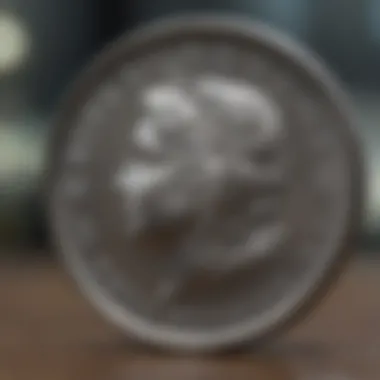
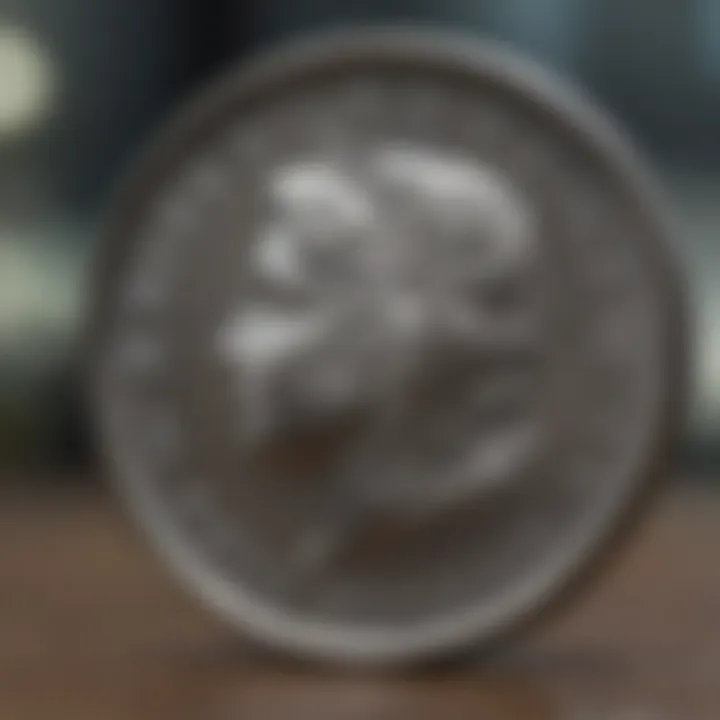
Intro
The journey into the realm of the $2 silver dollar unveils a rich tapestry woven with history, culture, and currency. It's not merely a coin; it embodies tales from a bygone era while serving practical functions in modern economies. The $2 silver dollar stands out among its peers, attracting collectors and investors alike with its uniqueness and potential for valuation in financial markets.
Understanding this currency requires grasping its historical backdrop and the evolution that led to its current status. Since its inception, the $2 silver dollar has been painted with nuances that affect everything from its desirability among collectors to the factors that influence its market worth.
In this comprehensive examination, we will dissect the terminology and definitions essential for navigating this fascinating world. This includes a closer look at key investment terms and financial concepts shaping the landscape for potential collectors and investors.
Hold tight, as we dive into the depths of the $2 silver dollar, equipping you with insights that enrich both the understanding and appreciation of this numismatic asset. The sections that follow will illuminate not only the historical significance but also the practical investment strategies that can be employed to make wise financial decisions. Through this exploration, you will arm yourself with knowledge to engage confidently with this unique piece of currency.
Historical Context of the $2 Silver Dollar
Understanding the historical context of the $2 silver dollar provides a vital framework for appreciating its value and significance. This section will emphasize the origins of the silver dollar and the key events that have shaped its narrative. The evolution of the $2 silver dollar reflects broader economic trends and cultural shifts, thus offering insights into its role not just as currency, but as a piece of American heritage.
Origins of the Silver Dollar
The origins of the silver dollar can be traced back to the Spanish dollar, or piece of eight, which was widely circulated in the Americas during the colonial period. This coin became a model as the United States sought to establish its own monetary system after gaining independence. The Coinage Act of 1792 set the stage, creating a standard for coinage and establishing the various denominations, importantly including the silver dollar.
The first official U.S. silver dollars were minted in 1794, and they featured the liberty cap, signifying freedom and independence. This choice of imagery reflects a focus on national identity and value that would carry through the decades. However, it was the 1840s and 1850s that truly brought silver dollars into their own, coinciding with the Gold Rush and the expansion of the American frontier. With silver abundant, the need for a reliable currency fostered the production of a variety of silver coins, including the iconic Seated Liberty dollar.
As the country matured, shifting economic preferences and the discovery of more silver mines made this metal the backbone of the nation's currency system. Notably, in 1878, the Morgan silver dollar was introduced and became a symbol of prosperity, enduring the test of time to remain relevant even to today’s collectors.
Key Historical Events Involving the $2 Silver Dollar
Several historical events have significantly influenced the narrative of the $2 silver dollar. One landmark moment occurred during the Great Depression in the 1930s when the U.S. government began to withdraw silver from circulation. This move was pivotal, as it increased the scarcity of silver coins, and consequently, their value began to rise in the eyes of collectors.
The Coinage Act of 1965 marked another turning point, as it reduced the silver content in coins, prompting some to view the remaining silver dollar designs, including the Eisenhower dollar of 1971, as relics of a bygone era. The period after the 1960s saw diminishing interest in silver as legal tender, which paved the way for the modern collector’s landscape.
In more recent years, the introduction of commemorative and special edition coins has generated renewed interest. The U.S. Mint’s decision to release modern designs that include the American Eagle series with its silver dollar representation reinvigorated the collector community and added layers to the historical importance of the $2 silver dollar.
"The narrative of the $2 silver dollar is not just about currency; it weaves a tapestry of American history, culture, and economics—every coin tells a story."
Physical Characteristics of the $2 Silver Dollar
The exploration of the physical characteristics of the $2 silver dollar is vital not only for numismatists but also for investors keen to understand the allure of this currency. Each coin tells a story through its design and minting process. The compelling visuals and materials used in these coins link their historical context to their ongoing value in the marketplace. By dissecting elements like design, manufacturing processes, and specific features like mint marks, collectors can gain a deeper appreciation for what sets the $2 silver dollar apart from other coins.
Design Elements
Portraits Featured
The portraits showcased on the $2 silver dollar play a crucial role in communicating its heritage. A common sight on these coins is the iconic image of Lady Liberty, who embodies not just the spirit of the United States but also represents freedom and democracy. This choice of portrait serves as a fine example of how symbolic imagery can enhance the appeal and worth of a coin.
Lady Liberty's portrayal offers several unique characteristics. One advantage is its clear connection to American ideals, making it a beloved symbol amongst collectors. However, some may argue that the frequent use of this portrayal could be seen as predictable, potentially overshadowing other artistic representations that convey deeper narratives about specific eras in American history.
"The portrayal of Lady Liberty isn't just decoration; it's a reflection of national values and aspirations throughout history."
Symbolism in Design
The symbolism embedded in the design of the $2 silver dollar cannot be underestimated. Various elements, such as the depiction of the eagle or olive branches, confer rich meaning. These elements together signify peace, strength, and resilience—themes that resonate deeply within the American ethos. Moreover, the choice of these symbols enhances the curiosity of collectors while also augmenting the sentimental value tied to the coin.
What makes this aspect especially significant for the article is the unique configurations found across different versions of the coin. While some designs may emphasize agricultural imagery, others lean towards industrial themes, reflecting the changing narratives of American society. However, these shifts can also confuse new collectors who might not grasp the context behind each design feature at first glance, necessitating additional education on this topic.
Mint Mark Significance
Delving into the mint mark of the $2 silver dollar reveals insights that are crucial for understanding its authenticity and value. Mint marks—small letters indicating where the coin was produced—are not mere embellishments; they are keys to identifying rarity and desirability. For example, a coin with a 'D' mint mark indicates it was struck in Denver, whereas a 'S' signifies San Francisco.
These distinctions matter because coins minted at different locations can vary significantly in terms of market value. Collectors often seek out rarer mint marks for their collections, and understanding these nuances helps enthusiasts navigate enthusiastically through marketplaces. However, the flip side is that these complexities can bewilder novice collectors, resulting in potential misinformed purchases.
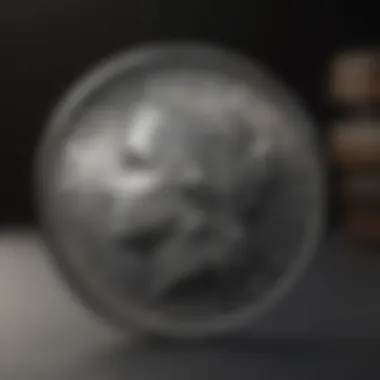
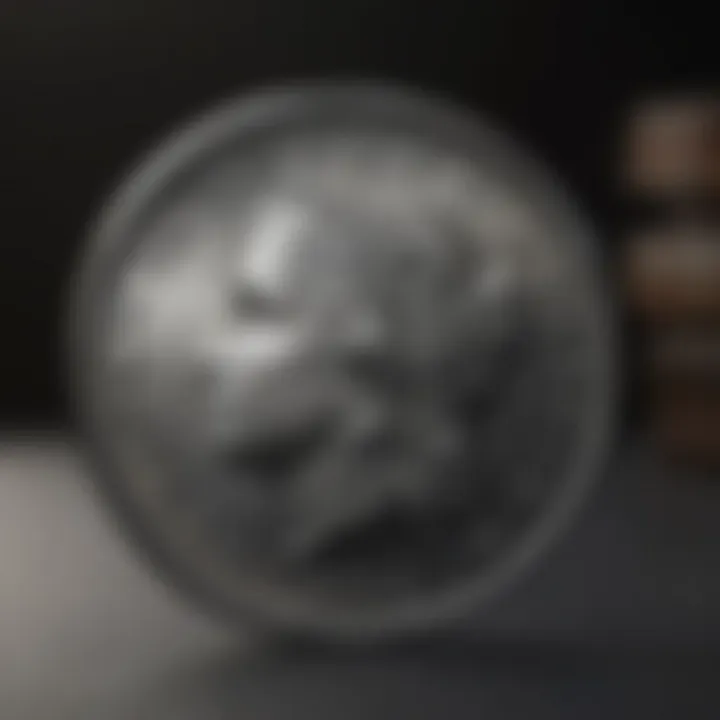
Minting Process
Materials Used
The materials used in the creation of the $2 silver dollar are a foundational aspect of its physical characteristics. Generally manufactured primarily from silver, specific quantities and alloy configurations contribute directly to the coin's weight and overall appeal. Historically, a higher silver content amounts to intrinsic value, which can fluctuate alongside the global silver market.
Moreover, the choice of high-grade silver adds to the visual luster of the coin, elevating it as a coveted item among collectors. However, considering the rising costs of silver, minting new quantities of this coin could pose financial challenges, affecting future releases and altering market demand.
Manufacturing Techniques
Finally, understanding the manufacturing techniques used to create the $2 silver dollar rounds up the series of considerations regarding its physical characteristics. Techniques such as die casting and engraving ensure crisp details and lifelike designs are not only produced but preserved over time. These processes contribute to the aesthetic qualities of the coin, making them alluring to collectors and investors alike.
The unique feature of advanced engraving techniques allows for higher clarity in portraits and symbols, making the coins easier to appraise for authentic traits. However, as modern minting adopts new technologies, some purists argue that these innovations could detract from the historical methods used in earlier coinage, erasing bits of the story behind each minting year.
Types of $2 Silver Dollars
Understanding the various types of $2 silver dollars is crucial. This section doesn't just delve into the coins themselves; it provides insights into the evolution of currency and the reasons for their unique characteristics. The different categories serve as a gateway to grasping the cultural, historical, and financial contexts surrounding these coins. Investors and collectors alike can benefit tremendously from this knowledge, as it not only enriches their appreciation but also influences investment strategies.
Variations Over Time
Early Issues
When we think about early issues of the $2 silver dollar, we are stepping into a fascinating moment in American numismatic history. These coins hail from a time when design and manufacturing were less automated, giving each piece its own unique character. A key characteristic that stands out is their often intricate designs and the notable artistry that went into them. Collectors value these early coins not just for their monetary worth, but for their historical context and the story they carry.
One prominent feature of these early issues is their limited mintage, making them a sought-after item. For instance, the release of the 1878 $2 silver dollar, which featured a beautiful rendition of Liberty, set a precedent for future coins, showcasing elegance that resonated with the public. This rarity can be an advantageous quality for collectors, as it potentially increases their value over time. However, it's essential to discuss the disadvantage too—some of these coins may be subject to higher wear due to being in circulation longer. This can impact their grading and perceived worth, which is something to keep in mind when considering an investment.
Modern Releases
On the flip side, modern releases of the $2 silver dollar represent a different approach. These coins, minted with advanced technology, typically boast higher levels of detail and consistency. A standout aspect is their availability. Unlike early issues, modern coins often have more substantial mintages, making them more accessible to a broader audience. For many, this is a beneficial element, as it allows newer collectors to enter the world of numismatics without breaking the bank.
An interesting feature of modern releases is the variety of designs. Some commemorative editions highlight historical milestones or significant events, infusing them with cultural relevance. While the accessibility of these coins might not yield as significant appreciation in value as rarer early issues, they still serve important roles in the market. Additionally, the relative ease of obtaining modern releases can sometimes lead to overproduction concerns, which could lower their long-term value when compared to more scarce options.
Special Editions
Special editions of the $2 silver dollar add an exciting layer to collecting and investing. They represent moments in time or commemorate events significant enough to warrant a dedicated design. Such editions often create buzz, attracting not only avid collectors but also casual buyers who see them as attractive items to own.
Commemorative Coins
Commemorative coins are like the cherry on top of the ice cream sundae of the numismatic world. These pieces often celebrate historical events, famous personalities, or cultural milestones. A notable characteristic of commemorative coins is their limited mintage, which often leads to increased demand. For example, a coin celebrating the Apollo 11 mission may not only be a piece of currency but also a nostalgic artifact of human achievement. This makes them a popular choice among collectors.
The unique designs offer both artistic appeal and historical significance, making these coins quite desirable. However, the downside can be their initial purchase price. They often command a premium over regular issues due to their limited nature, and their future value can be somewhat unpredictable.
Limited Edition Mintings
Limited edition mintings are the hidden gems that can significantly elevate a collection. These coins might be produced to coincide with a specific event, like a centennial or a significant anniversary. A key characteristic of these mintings is their exclusivity. They are deliberately made in smaller quantities, convincing collectors about their unique status. This can make them a wise option for investors who understand the demand for scarcity in the numismatic market.
On the flip side, the limited nature can also mean higher risks. If market demand doesn’t align with the expectations, collectors might find themselves holding onto a coin that doesn’t appreciate as anticipated. Therefore, potential investors should do their homework, understanding not only the coin but the circumstances and state of the market in which it resides.
Market Valuation and Investment Potential
Understanding the market valuation and investment potential of the $2 silver dollar is critical for anyone looking to navigate the intricacies of coin collecting or investment. This section examines the various elements impacting the coin's value, guiding readers through the landscape of appraisal and investment. Coins aren’t just simple currency; they’re a blend of history, artistry, and economics. Grasping why these attributes matter can enrich one’s appreciation and understanding of the market.
Factors Influencing Market Value
Rarity and Demand
Rarity plays a pivotal role in shaping the market value of the $2 silver dollar. When a coin is difficult to find, collectors usually get excited. This excitement can lead to increased demand. Consider this: if a specific edition of the $2 silver dollar is in limited supply, collectors may be willing to pay a premium to own it. This cycle of rarity driving demand enhances the overall value.
Moreover, the thrill of the hunt is real. Many collectors feel a sense of accomplishment when they find a rare coin. This emotional attachment often translates into a willingness to invest more money in rare editions. On the flip side, if a particular coin becomes too common, it can lead to a decrease in its value. This volatility makes rarity a double-edged sword in the market.
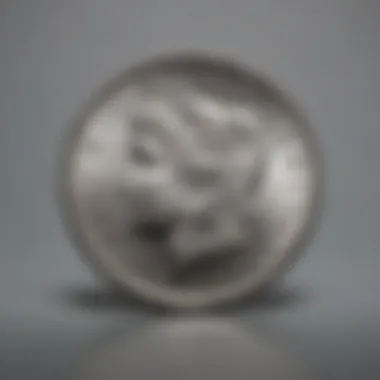
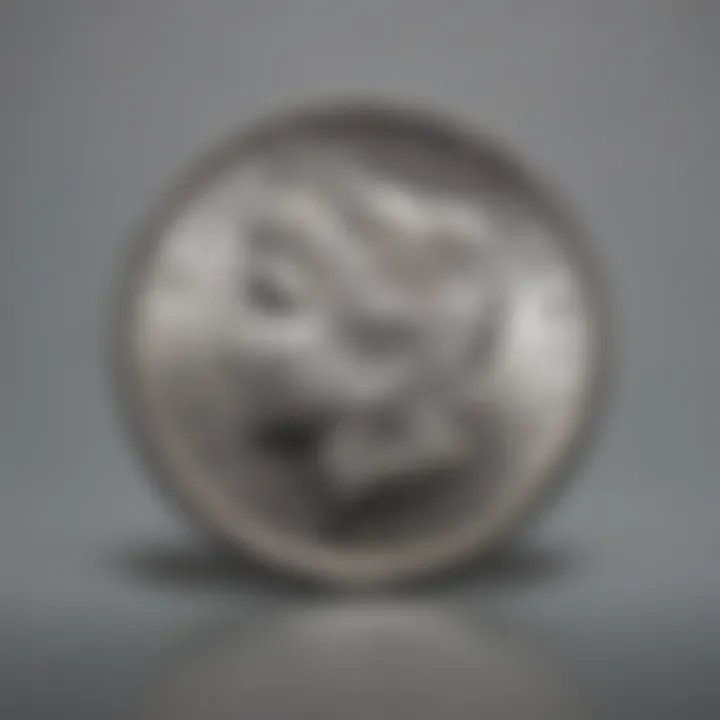
Condition and Grading
The condition and grading of a coin profoundly influence its market value. Coins are evaluated based on their state of preservation; a coin in impeccable condition can command a higher price than one that's seen better days. The grading scale ranges from 'poor' to 'mint state,' with collectors paying a premium for higher grades.
Being knowledgeable about grading can save investors from costly mistakes. For instance, a collector should understand that a coin graded as ‘mint’ is significantly more valuable than one labelled ‘good.' However, grading can be subjective and varies among collectors, which may lead to discrepancies in what individuals are willing to pay. Knowing this can help navigate potential pitfalls in coin valuation.
Comparing the $2 Silver Dollar to Other Coins
Comparison with Gold Dollars
When comparing the $2 silver dollar to gold dollars, two aspects immediately come into focus: material and value stability. Gold has historically been viewed as a safe haven asset, often holding its value well against inflation. In contrast, while the $2 silver dollar also holds historical significance, it does not always enjoy the same level of price stability.
The allure of gold dollars often stems from their intrinsic value. They are considered a hedge in uncertain economic climates, which means they frequently draw investors' attention during market downturns. Conversely, $2 silver dollars could see fluctuations that correlate more with collector interest rather than fundamental economic forces. Thus, for investors, it is crucial to be aware that while both coins have their perks, their market dynamics can differ quite a bit.
Performance Against Other Commodities
Looking at the performance of the $2 silver dollar against other commodities sheds light on its potential as a sound investment. Commodities like oil, agricultural products, and metals often shift in price due to their reliance on supply and demand. The value of the $2 silver dollar, however, can also be influenced by collector demand and specific historical importance as well.
Generally, precious metals, including silver, showcase a broader market influence, especially during economic instability. In such times, $2 silver dollars can gain traction among collectors who may overlook fluctuations in other commodities. Yet, potential investors should be cautious. It's not just about jumping on trends; consider a holistic view of asset performance across various markets.
"The world of numismatics is not merely a past-time; it is an investment laden with histories and stories waiting to be uncovered."
Understanding these dynamics around rarity, condition, and comparisons to other valued coins enables collectors and investors alike to make informed decisions in the unpredictable world of coin collecting.
Cultural Significance of the $2 Silver Dollar
The cultural significance of the $2 silver dollar reaches far beyond its mere financial value. This currency connects with various aspects of American history, art, and the collector community, making it a multifaceted subject of study. Recognizing its impact helps one appreciate not just the coin itself, but the stories and sentiments it carries.
Role in American History
Symbol of Wealth
The $2 silver dollar has often been viewed as a symbol of wealth throughout American history. Its larger denomination, in an era when coins had tangible value, represented a substantial sum. Wealth was not merely about banknotes; it was about possessing physical assets that could hold or even grow in value.
This coin illustrates the economic conditions of its time, reflecting the aspirations of individuals in pursuit of prosperity. It also highlights the growing importance of silver in shaping the American financial landscape. The very existence of the coin mirrors the significance of silver mining and trade, particularly in the 19th century.
Inevitably, this coin became a beneficial choice for collectors and investors alike due to its historical context. Owning a $2 silver dollar is akin to holding a piece of history. It stands as a testament to a time when wealth was visibly measured in the coins one carried, rather than in digits on a screen. However, it can be a double-edged sword since the market fluctuations and the coin's rarity mean that its value can vary over time, impacting its perceived wealth status among collectors.
Representation in Literature and Art
The representation of the $2 silver dollar in literature and art is notable. This coin has made appearances in various narratives, perhaps often symbolizing dreams of wealth and prosperity, or sometimes as a metaphor for loss and nostalgia.
These artistic representations illustrate not just the physical coin but also evoke the feelings, aspirations, and struggles of people throughout different eras. For instance, in novels from the 19th century, references to the $2 silver dollar often reflect the pursuit of the American Dream, depicting characters whose fate is intricately linked to the coin’s value.
This unique feature provides a rich layer of context in analyzing the coin's significance, making it a fertile ground for academic exploration. Literature and art have the power to shape perceptions and bring deeper understanding into how the $2 silver dollar is viewed culturally. However, its interpretations can also vary. Some artistic depictions might take a critical view on wealth, challenging society's values surrounding materialism which can lead to debates within the community.
Collector Community
Collectors play an integral role in the narrative surrounding the $2 silver dollar. Understanding their motivations can reveal much about how value is perceived in both historical and contemporary settings.
Motivations Behind Collecting
The motivations for collecting coins, specifically the $2 silver dollar, extend beyond mere financial gain. Many collectors are driven by a passion for history and the stories behind each piece. Delving into the narratives tied to different issues of the silver dollar can be a catalyst for learning, as collectors seek to understand the circumstances during which the coins were minted. This fervor can lead to establishing rich connections with the broader tapestry of American heritage.
Additionally, collecting can also provide a sense of community among enthusiasts. It brings people together who appreciate the artistry and historical weight of each coin, forming bonds over shared interests. However, the fluctuation in market value can introduce a competitive edge in some collectors, as they may speculate on future values and rarity.
Prominent Collectors and Their Impact
The impact of prominent collectors cannot be understated in the realm of numismatics, particularly concerning the $2 silver dollar. Well-known figures in this space have shaped the market and influenced trends. Their collections often serve as benchmarks, guiding the perceptions of value and rarity to new collectors.
One of the most notable aspects is how prominent collectors often share their knowledge, helping to educate newcomers about the nuances of collecting. Their enthusiasm can inspire others to explore, invest, or deepen their understanding of this fascinating world.
However, this prominence can also lead to disparities. Most notably, the focus on high-value coins can divert attention from lesser-known issues or variations that hold historical significance but may not fetch impressive prices. This dichotomy creates a layered landscape within the collecting community, underscoring the complexity and varied motivations individuals have when it comes to amassing these unique historical artifacts.
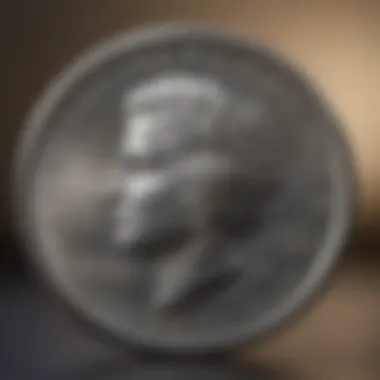

"The $2 silver dollar transcends its monetary value, serving as a mirror to the cultural and historical significance that shapes American identity."
Care and Preservation of $2 Silver Dollars
Taking care of $2 silver dollars is not just about protecting a piece of history; it’s about ensuring their value remains intact for collectors and investors alike. The importance of proper care transcends mere aesthetic considerations—it plays a crucial role in maintaining the integrity and potential future valuation of these numismatic assets. Coins, as tangible objects, are susceptible to environmental factors, handling techniques, and improper storage, which can all lead to degradation. Thus, understanding the best practices in handling and storage for these coins is paramount.
Best Practices for Handling
When it comes to handling $2 silver dollars, there are several best practices one ought to consider to minimize the risk of damage. Coins should always be held by the edges to avoid fingerprints, oils, and dirt that can potentially tarnish their surface.
- Use Soft Gloves: Wearing cotton gloves can provide a barrier between the coin and natural oils from your skin, preventing unwanted marks.
- Avoid Direct Contact: Whenever possible, hold the coins using a flat, smooth surface or use holders and flips designed for coins.
- Stay Calm: Sudden movements can cause accidents; try to handle each coin gently and delicately to avoid any unintended drops.
Maintaining these practices will go a long way in ensuring the condition of your $2 silver dollars remains optimal.
Storage Recommendations
Choosing the right storage conditions is equally important for the preservation of these coins. The aim is to protect them from environmental hazards and physical damage that can occur during their life cycle.
Optimal Conditions
The optimal conditions for storing $2 silver dollars are characterized by controlled temperature and humidity levels, which play a vital role in preventing oxidation and corrosion.
- Temperature: Keeping coins in a consistent, moderate temperature that hovers around room temperature minimizes expansion and contraction. Extremes can crack or warp the coin material.
- Humidity: A relative humidity of around 30-50% establishes a safe environment that significantly reduces the chances of moisture-induced tarnishing while discouraging mold growth.
These conditions can be beneficial because protected coins can retain their luster and purity, making them more appealing to future buyers or investors.
Materials for Preservation
Selecting the right materials for storage is equally vital. Acid-free holders are an excellent choice for safely housing $2 silver dollars.
- Coin Holders and Capsules: Clear, non-PVC holders prevent air exposure while allowing visibility to appreciate the coin's beauty.
- Mylar Flips: These provide a low-cost solution that is safe for long-term storage, as they do not contain harmful chemicals that can damage the coins over time.
The unique feature of these preservation materials is their ability to provide both protection and visibility. However, while some materials are economical, others can be costly but may offer greater long-term safeguards for your prized collection.
In summary, careful handling techniques coupled with optimal storage conditions and specialized materials can significantly enhance the longevity of $2 silver dollars. By following these guidelines, collectors and investors can ensure that their coins not only maintain their immediate beauty but also their long-term value.
Future Outlook for $2 Silver Dollars
The future outlook for $2 silver dollars offers a fascinating glimpse into how this unique currency might evolve over the coming years. As more individuals express interest in collecting and investing in coins, understanding the nuances of the market becomes more important. This section aims to illuminate potential trends and implications for collectors and investors alike.
Market Trends and Predictions
Market trends surrounding the $2 silver dollar can be quite telling. Experts often point out that fluctuations in the metal market heavily influence the coin's value. For example, when silver prices skyrocket, coins made primarily from this metal tend to see their worth climb as well. Even within the collector community, demand can vary significantly based on economic conditions. Recent news indicates a growing interest among younger investors in numismatic assets, which could prove beneficial for the value of coins like the $2 silver dollar.
It’s also worth noting that online platforms, like Reddit, are buzzing about coin collecting, drawing in a crowd that values both history and investment.
"Understanding the market dynamics can be the silver lining for any collector or investor in the numismatic landscape."
Advice for Potential Investors
Understanding Market Cycles
Market cycles play an essential role in the valuation of the $2 silver dollar. Recognizing these cycles helps investors make informed decisions. One key characteristic of market cycles is that they can be cyclical—historically, prices have tended to rise and fall in patterns related to economic conditions. Investors who grasp these trends can position themselves strategically, especially during downturns when prices might be more favorable for acquisition.
A unique feature of understanding the market cycles is how they often mirror broader economic trends. When the economy falters, more investors turn to tangible assets, which can spur interest in collectibles like the $2 silver dollar. +Thus, savvy investors might consider this cyclical pattern a beneficial opportunity for making sound investments in the future.
Long-term Versus Short-term Investments
When considering the $2 silver dollar, distinguishing between long-term and short-term investment strategies is crucial. Long-term investments typically focus on patience, allowing the value of the coin to appreciate over time. Investors favor this approach due to its potential for substantial gains, particularly if historical trends are taken into account. However, the market can be fickle; short-term investments might appeal to those who want immediate returns or aim to make quick profits based on market movements.
Moreover, short-term investing offers the thrill of quickly turning around profits in a fast-paced market. Still, it carries the risk of volatility, where market dips could impact the potential for immediate gains.
Both approaches—long-term and short-term—hold their unique advantages and drawbacks, making it essential for investors to define their strategy based on their financial goals and risk tolerance.
Being aware of these market dynamics and investment strategies will not only inform decisions but also enhance appreciation for the $2 silver dollar as a significant player in the world of collectibles, blending both monetary value and historical significance to craft an intriguing investment profile.







